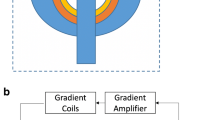Abstract
A technique that allowsin vivo measurements of the specific impedance of brain structures is analysed and implemented. This technique uses the 4-electrode method. The system includes an optically isolated current source and an interchangeable electrode module. Tests on the measuring system, including the electrodes and calibration procedures, are presented. Experiments in media of known resistivity and in cat brains define the present limits of the spatial resolution.
Sommaire
L'article décrit une technique permettant de mesurerin vivo l'impédance spécifique des structures du cerveau, ainsi que sa mise en oeuvre. Cette technique adopte la méthode à quatre électrodes. Le système comprend une source de courant optiquement isolée, et une unité interchangeable à électrodes. L'article présente des essais sur le système de mesure, y compris les électrodes et les procédures d'étalonnage. Les expériences dans des milieux de résistivité connue et dans des cerveaux de chats définissent les limites actuelles de la résolution spatiale.
Zusammenfassung
Eine Methode, welche diein-vivo-Messungen der spezifischen Impedanz von Gehirnstrukturen zuläßt, wird analysiert und implementiert. Das Verfahren basiert auf der 4-Elektroden-Methode. Das System beeinhaltet eine optische isolierte Stromquelle und ein auswerchselbares Elektrodenmodul. Tests am Meßsystem einschließlich Elektroden- und Eichverfahren werden präsentiert. Experimente an Medien von bekanntem spezifischem elektrischem Widerstand sowie an Katzengehirnen definieren die gegenwärtigen Grenzen der räumlichen Auflösung.
Similar content being viewed by others
References
Adey, W. R., Kado, R. T., Didio, J. andSchindler, W. J. (1963) Impedance changes in cerebral tissue accompanying a learned discriminative performance in cat.Exptl. Neurol. 7, 259–281.
Ferris, C. D. andStewart, L. R. (1974) Electrode produced signal distorsion in electrophysiological recording systems.IEEE Trans. BME-21, 318–326.
Frank, K. andBecker, M. L. (1963)Physical techniques in biological research (W. L. Nastuk, Ed.) Academic Press, New York, vol. 5, 28–84.
Geddes, L. A. andBaker, L. E. (1967) The specific resistance of biological material. A compendium of data for the biomedical engineer and physiologist.Med. & Biol. Eng. 5, 271–293.
Jasper, H. H. andAjmone-Marsan, C. (1954) A stereotaxic atlas of the diencephalon of the cat. National Research Council of Canada.
Loucks, R. B., Weinberg, H. andSmith, M. (1959) The erosion of electrodes by small currents.EEG. Clin. Neurophysiol. 11, 823–826.
Nicholson, P. W. (1967) Experimental models for current conduction in an anisotropic medium.IEEE Trans. BME-14, 55–56.
Pollak, V. (1974a). Impedance measurements on metal needle electrodes.Med. & Biol. Eng. 12, 606–612.
Pollak, V. (1974b) An equivalent diagram for the interface impedance of metal needle electrodes.12, 454–459.
Pollak, V. (1974c) Computation of the impedance characteristic of metal electrodes for biological investigations.12, 460–463.
Robinson, B. W. (1962) Localisation of intracranial electrodes.Exptl. Neurol. 6, 201–223.
Robinson, B. W. andTompkins, H. E. (1964) Impedance method for localising brain structures.Arch. Neurol. 10, 563–574.
Robinson, B. W., Rosuold, H. E. andBryan, J. S. (1965) Further extension of the impedance method (including direct current recording) for locating brain structures.Neurol. 15, 277.
Rush, S. (1962) Methods of measuring the resistivities of anisotropic conducting media in situ.J. Res. Nat. B. Stand. C. Eng. Instr.,66c, 217–222.
Rush, S. andDriscoll, D. A. (1968) Current distribution in the brain from surface electrodes.Anesthesia & Analgesia Current Res. 47, 717–723.
Schwan, H. P. (1963). Physical techniques in biological research. (W. L. Nastuk, Ed.) Academic Press, New York, vol. 6, chap. 6.
Schwan, H. P. (1966) Alternating current electrode polarisation.Biophysik 3, 181–201.
Shalit, M. N. andMahler, Y. (1966) Brain impedance measurements by the use of small bipolar needle electrodes.J. Appl. Physiol. 21, 1237–1242.
Tachibana, S., Aguilar, J. andBirzis, L. (1970) Scanning the interior of living brain by impedography.28, 534–539.
Witwer, J. G., Tresek, G. J. andJewett, D. L. (1972) The effect of media inhomogeneities upon intracranial electric fields.IEEE Trans. BME-19, 352–362.
Author information
Authors and Affiliations
Rights and permissions
About this article
Cite this article
Robillard, P.N., Poussart, Y. Specific-impedance measurements of brain tissues. Med. Biol. Eng. Comput. 15, 438–445 (1977). https://doi.org/10.1007/BF02457999
Received:
Accepted:
Issue Date:
DOI: https://doi.org/10.1007/BF02457999




